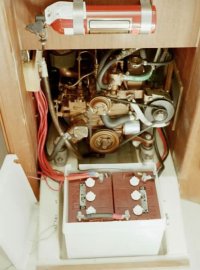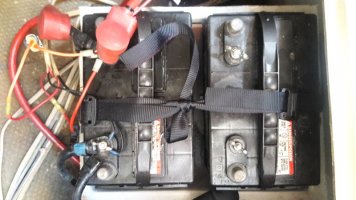There seems to be an on-going Ericson discussion of battery upgrades or changes. Here is a picture of the main change I made to our Olson. The original set-up from the factory was a pair of group 24 12-volt batteries mounted under the bottom step, in a molded-in pan in front of the engine. I took them out when they were near the end of their life, at 7 years. I put in a separate starting battery under the aft cabin berth. I put a pair of Trojan T-145 golf cart batteries where the smaller 12's used to be.
The new "house" bank is now 244 amp hours. This pair weighs 144 #. This is about the equivalent of a single "8D".
Our starting battery is a Trojan AGM, sized close to a "group 31", and is a bit oversized for our 3 cylinder diesel, but I would rather have too much power rather than too little on a cold morning.
Loren in Porland, OR
Olson 34 #8

The new "house" bank is now 244 amp hours. This pair weighs 144 #. This is about the equivalent of a single "8D".
Our starting battery is a Trojan AGM, sized close to a "group 31", and is a bit oversized for our 3 cylinder diesel, but I would rather have too much power rather than too little on a cold morning.
Loren in Porland, OR
Olson 34 #8



